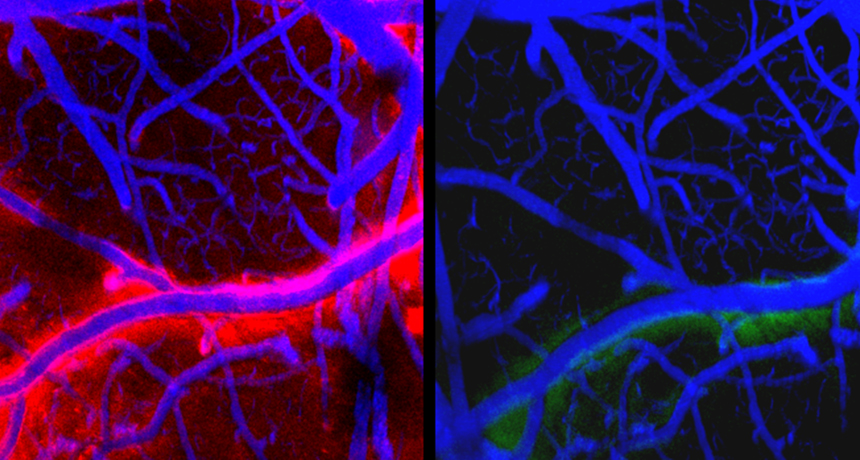Sleeping brains take a bath
As mice sleep, brain fluid washes away the junk that built up between cells while awake

In a sleeping mouse, dyed fluid (red) seeped deeply into the spaces between brain cells. But when a mouse was awake, fluid (green) didn’t flow very far.
L. XIE, H. KANG AND M. NEDERGAARD
All day long, litter builds up between brain cells. A study now finds that trash is washed away by fluid in the brain during sleep. That’s potentially good news because such garbage includes a substance linked to Alzheimer’s disease.
Evidence of this brain-washing emerged in a study on mice. But the finding gives researchers an idea of what may happen in the brains of sleeping people, too.
Chiara Cirelli called the new findings “eye-opening and intriguing.” A sleep researcher at the University of Wisconsin–Madison, she did not work on the new study.
The new brain-cleaning discovery was a real surprise, notes Maiken Nedergaard. A neuroscientist, she works at the University of Rochester Medical Center in New York.
Her team had been studying a drainage process in the brain that acts like a sewer system. Its formal name is the glymphatic system. What the scientists hadn’t expected was to uncover that this system performs differently during slumber than it does while animals are awake. As the study’s animals slept, fluids began flowing from the brain and spinal cord into the spaces between brain cells. These fluids washed away the junk that had built up while the animal was awake.
The researchers published their new findings October 18 in the journal Science.
The buildup of litter was not unexpected. In fact, other studies had shown that during waking hours, brain cells pump out bits of protein and other substances. The longer someone stayed awake, the more that litter built up. That trash included amyloid-beta. This protein fragment accumulates in the brains of people with Alzheimer’s disease. This condition impairs a person’s ability to think, learn and remember.
Lulu, the ‘mouse whisperer’
Of course, studying the brains of mice isn’t easy. The animals constantly move during waking hours. Luckily, the scientists had a secret weapon: Lulu Xie.
“She’s the mouse whisperer,” explains team member Jeffrey Iliff. He’s a neuroscientist at the Oregon Health & Science University in Portland.
Xie knew that mice scurry by night and sleep by day. But during the day a lab is noisy. Xie’s challenge was to help mice sleep through all that racket. Her solution was to switch the sleep schedule of the mice. By making it dark during the day and bright at night, her mice learned to sleep when the lab was quiet.
Xie also kept the mice warm and treated them to sugar water after experiments. Not surprisingly, Nedergaard told Science News for Students, “The mice really like her.”
Xie’s efforts worked well — really well. Sometimes, those warm and comfy mice dozed even while their brains were being probed. And that’s when Nedergaard’s team made its surprise discovery.
Like opening a faucet
Once the mice fell asleep, fluid floodgates into their brain opened. “It was almost like you opened a faucet,” Nedergaard says. As the fluid passed through the spaces between brain cells, it washed away the cellular litter. (That litter winds up in the liver, which disposes of it.) The faucet slowed to a trickle when the mice woke up.
The scientists then looked closely at the brain cells. They found that the cells shrink during slumber — enough to open space through which the fluid can flow freely. When mice are awake, the cells swell, lessening the fluid’s flow.
The newfound housecleaning activity occurs in a part of the brain that few people study, notes neuroscientist Suzana Herculano-Houzel. That space between cells is “usually disregarded. It’s considered just space,” she told Science News. Herculano-Houzel, who works at the Federal University of Rio de Janeiro in Brazil, did not work on the new study.
The new sleep-cleaning discovery also may help scientists solve an age-old mystery: Why do animals sleep?
Every animal does it. Without it, they die — although no one knows quite why. Some studies suggest that the brain solidifies memories during sleep. However, notes Nedergaard, “You don’t die from forgetting what you learned yesterday.”
POWER WORDS
Alzheimer’s disease A mental deterioration that affects a person’s behavior, memory and brain function.
amyloid-beta A protein fragment that can build to high levels in the brains of people who have Alzheimer’s disease. Over time, this material can lead to localized cell death.
glymphatic system A system that moves cerebrospinal fluid through channels in the brain of mammals, removing potentially harmful wastes.
neuroscience Science that deals with the structure or function of the brain and other parts of the nervous system. Researchers who work in this field are called neuroscientists.
proteins Compounds made from one or more long chains of amino acids. Proteins are an essential part of all living organisms. They form the basis of living cells, muscle and tissues; they also do the work inside of cells.
spinal cord A cylindrical bundle of nerve fibers and associated tissue. It is enclosed in the spine and connects nearly all parts of the body to the brain, with which it forms the central nervous system.







